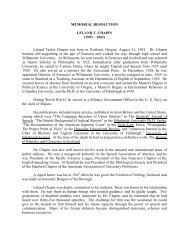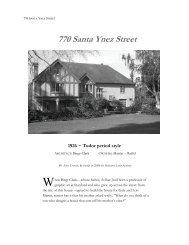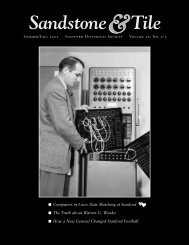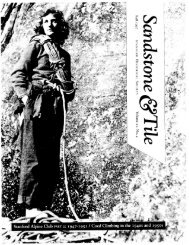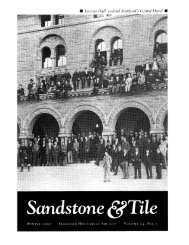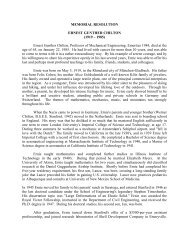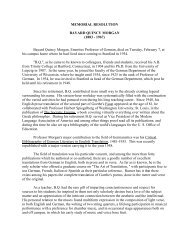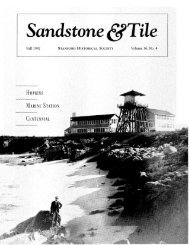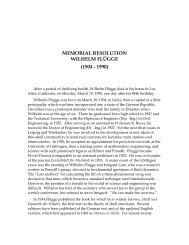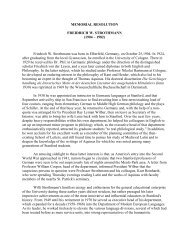"The Sam McDonald Story," by Jeff Littleboy - 1 - Stanford Historical ...
"The Sam McDonald Story," by Jeff Littleboy - 1 - Stanford Historical ...
"The Sam McDonald Story," by Jeff Littleboy - 1 - Stanford Historical ...
Create successful ePaper yourself
Turn your PDF publications into a flip-book with our unique Google optimized e-Paper software.
Annual Feature Edition of the <strong>Stanford</strong> <strong>Historical</strong> Society Newsletter Volume 7, No. 2lWinter 1983<br />
"<strong>The</strong> <strong>Sam</strong> <strong>McDonald</strong> <strong>Story</strong>," <strong>by</strong> <strong>Jeff</strong> <strong>Littleboy</strong> - 1 <strong>Stanford</strong> <strong>Historical</strong> Society Newsletter
<strong>The</strong> editor wishes to thank Mrs. John Ceidburg (Helen Louise<br />
"Holly" Hansen, '40) for her indispensable help in the produc-<br />
tion of this article. She provided pictures from her personal<br />
collection of <strong>McDonald</strong>iana, and a variety of anecdotes about<br />
<strong>Sam</strong>, otherwise unavailable. At <strong>Stanford</strong> she was an A 0 Pi, a<br />
member of Pan Hellenic Council, Phi Beta Kappa and <strong>The</strong>ta<br />
Sigma Phi, honorary journalism society.<br />
<strong>The</strong> Hansen family interest in <strong>Stanford</strong> was stimulated <strong>by</strong> her<br />
father's acquaintance with Almon E. Roth in Rotary Club activi-<br />
ties. <strong>The</strong> former was a Michigan lumberman who made an<br />
annual trip west to buy redwood. Holly was followed at Stan-<br />
ford <strong>by</strong> two brothers, Arthur B., '42, and Hal J., '57. Her hus-<br />
band is a Kansas University grad who is an engineering man-<br />
agement consultant. <strong>The</strong>y live in Aptos.<br />
After graduation, Holly was secretary to Ruth Atwood, su-<br />
perintendent of the <strong>Stanford</strong> Convalescent Home, and was a<br />
onetime assistant in the Registrar's Office. She later became an<br />
assistant editor at Sunset Books, and is now working on a<br />
history of Michigan iron mining areas for the state's 1984<br />
centennial.<br />
One of her many <strong>McDonald</strong> anecdotes runs this way: "On<br />
one occasion, his La Honda neighbors brought him a petition<br />
against a man who was raising pigs too close to the village.<br />
Instead of signing, <strong>Sam</strong> solved the problem <strong>by</strong> buying the<br />
man's holdings - land, houses, pigs and all, and making the<br />
necessary changes himself!"<br />
Did <strong>Sam</strong> play down his Negro heritage? No one really knows,<br />
but Mrs. Ceideburg offers some contrasts: He ran off some<br />
rowdies who came to visit him, as who wouldn't? Yet he was<br />
greatly pleased with the Indian symbol for <strong>Stanford</strong> teams, as<br />
they were named in those days. Most of his working life <strong>Sam</strong><br />
had been associated with and interested in Scandinavian peo-<br />
ple and lore, and he was intrigued to learn of Danish-speaking<br />
Negroes in the West Indies.<br />
Mrs. Ceideburg has turned over her voluminous collection of<br />
material on <strong>Sam</strong> to the <strong>Stanford</strong> University Archives, "and<br />
where there were duplicates, to the (San Mateo County) park."<br />
Me1 Nelson, retired superintendent of facilities and grounds<br />
of the Athletic Department, also turned over many of his per-<br />
sonal photographs of <strong>Sam</strong> to the park.<br />
<strong>The</strong> staffers there were delighted to learn, for the first time,<br />
the history of the man who donated the park.<br />
COVER: A banner day for <strong>Sam</strong>, when <strong>Stanford</strong> President Ray<br />
Lyman Wilbur dedicated <strong>Sam</strong> <strong>McDonald</strong> Road near Angel1<br />
Field. Now a mall, it runs between Encina Gym and the<br />
football stadium.
<strong>The</strong><br />
SAM McDONALD<br />
STORY<br />
He was certainly the first black man to supervise<br />
the athletic plant at a major university, and his devotion<br />
to the <strong>Stanford</strong> Convalescent Home kids was legendary . . .<br />
<strong>Sam</strong> <strong>McDonald</strong>, <strong>Stanford</strong> University's most famous<br />
superintendent of athletic buildings and grounds, was a<br />
man of parts and contrasts. Certainly he was the first<br />
black man to hold such an important position at a un-<br />
iversity - regional though <strong>Stanford</strong> may have been in<br />
those early days.<br />
Though his name lives on in Santa Clara and San<br />
Mateo counties, not many nowadays remember him. But<br />
<strong>Sam</strong> <strong>McDonald</strong> Mall runs between the stadium and En-<br />
cina Gym, and is used every day <strong>by</strong> hundreds of students<br />
- which would have pleased him.<br />
And <strong>Sam</strong> <strong>McDonald</strong> Park in San Mateo County ram-<br />
bles across some 450 unspoiled acres of towering red-<br />
woods, babbling creeks and deep ravines, bordered <strong>by</strong><br />
Pescadero Road, which also traverses it, Alpine Road and<br />
La Honda Road (State Route 84).<br />
<strong>Sam</strong> willed the land to <strong>Stanford</strong> "for all to enjoy," but<br />
for practical reasons the University turned it over to San<br />
Mateo County for a park. Significantly, it permits no auto<br />
traffic - only equestrians and hikers.<br />
It was there on April 17,1982 that the <strong>Historical</strong> Society<br />
celebrated "<strong>Sam</strong> <strong>McDonald</strong> Day" with a picnic and a talk<br />
<strong>by</strong> Holly (Mrs. John) Ceideburg, of Aptos, who recalled<br />
the days of a man who was everybody's friend, and<br />
whose work parties and barbecues made "Con Home<br />
Day" a <strong>Stanford</strong> tradition for more that a quarter of a<br />
century.<br />
Park officials were also in attendance, pleased to learn<br />
more about their special domain.<br />
Mrs. Ceideburg is the editor of <strong>Sam</strong> <strong>McDonald</strong>'s Farm, a<br />
biographical labor of love that kept her busy for many<br />
years. <strong>Sam</strong> loved to talk, and she often had to shush the<br />
garrulous oldster so she could get her notes pinned<br />
down.<br />
<strong>Sam</strong>'s original manuscript was wonderful, she recal-<br />
led, but far too rambling and verbose. She had to con-<br />
dense and cut it <strong>by</strong> half. He loved to use two words where<br />
one might do, and he loved archaic expressions. Things<br />
didn't "happen," they "came to pass." You never were<br />
broke, you just had a "lamentable impecuniosity," and a<br />
problem was a "perplexion."<br />
Mrs. Ceideburg, his friend for 20 years, found him to<br />
be a complex character who seemed to be perfectly<br />
straightforward, but who would go to great lengths in<br />
order to make things "come to pass." He could be naive<br />
and foxy, subdued and brash, humble and bold, serious<br />
and comic, quiet and noisy- every contrast in the book.<br />
"Just think of good adjectives and they are all appropri-<br />
ate for <strong>Sam</strong>," she said. "Happy, benevolent, generous,<br />
confident, kind, optimistic, dependable, loyal, warm-<br />
hearted, honest - generally 'upbeat', as the kids would<br />
say today."<br />
<strong>Sam</strong> was born Emanuel Bruce <strong>McDonald</strong> on a planta-<br />
tion near Monroe, Louisiana nearly a century ago, on<br />
January 1, 1884. <strong>The</strong> family's given name came from the<br />
Scottish landowners.<br />
His grandfather could read and write and was given<br />
his freedom in the 1840's. His grandmother was half<br />
Choctaw Indian, and <strong>Sam</strong> was very proud of his lh Indian<br />
heritage. His erect carriage and high cheekbones empha-<br />
sized his bloodlines, and he always expressed great inter-<br />
est in Indian lore.<br />
His father was Peter Bird <strong>McDonald</strong>, who was a free<br />
and educated man before the Civil War. He was a farmer<br />
and a Methodist minister. His mother, Patricia Wheatley,
was born into slavery but was too young to remember<br />
much about it.<br />
<strong>Sam</strong> was never a Southerner, as many believed. He<br />
and his family moved to Southern California in 1890<br />
when he was six. His father farmed sugar beets around<br />
Tustin, Santa Ana, Chino and Pomona, and preached,<br />
occasionally substituting for the Reverend Tully Knoles.<br />
At the funeral of <strong>Sam</strong>'s mother, Reverend Knoles offici-<br />
ated. <strong>Sam</strong>'s father and Knoles Senior, an attorney in<br />
Ontario, were life-long friends.<br />
SAM MC DONALD<br />
COUNTY PARK<br />
- ---- PARK BOUNDARY<br />
- PAVED ROAD<br />
=r======= DIRT ROAD<br />
HIKING TRAILS:<br />
h PICNIC AREA<br />
0 RESTROOM<br />
4 * 6 L RIDGE LOOP TRAIL<br />
bbbebbbbb FORESTLOOP<br />
+H+H+H- BIG TREE LOOP<br />
----- OTHER TRAILS<br />
<strong>The</strong> family moves<br />
When <strong>Sam</strong> was 13, the family moved north to Santa<br />
Clara County. It took them three weeks, with horses,<br />
cows, wagons, farm equipment, and household goods.<br />
<strong>The</strong>y camped in the Pacheco Pass en route to the sugar<br />
beet fields, and they became the first black family in<br />
Gilroy .<br />
<strong>The</strong>y went to work for the Gubser family, where <strong>Sam</strong><br />
milked 21 cows a day. His father organized and became<br />
superintendent of Gilroy's first Sunday school. <strong>Sam</strong>'s<br />
schooling ended in the seventh grade, but his brother<br />
Jesse later went to college in Louisiana.<br />
And here begins an amazing tale of pluck and luck, all<br />
because <strong>Sam</strong> wouldn't leave California. At the turn of the<br />
century when he was 16, <strong>Sam</strong>'s family, with some others,<br />
decided to move north.<br />
His father and Jesse eventually made it to Walla Walla<br />
and later Seattle, but <strong>Sam</strong> turned back at the California<br />
line and never saw them again. He beat his way back to<br />
the Bay Area, selling his skills as a horse trainer and<br />
saving his money. In San Francisco he was found too<br />
young for merchant seaman duty, so he tried out as an<br />
artist's model.<br />
But he was too bashful, and didn't show up on the<br />
second day. <strong>The</strong>n he took a job on the San Francisco-<br />
Sacramento river boat Modoc, as chore boy, swamper,<br />
and galley hand. Incidentally, feeling his oats, he picked<br />
up a few dollars as a boxer.<br />
In San Francisco, he remembered the death of Queen<br />
Victoria when the British seamen in port marked the<br />
event; he watched President McKinley christen the<br />
battleship "Ohio," and marked the death of Collis P.
two walked 18
sparring partners, into which he was inveigled <strong>by</strong> a stu-<br />
dent practical joker.<br />
He participated in all the campus shows and carnivals,<br />
gave flowers to young couples although he was a life long<br />
bachelor, and was always full of advice to the lovelorn,<br />
playing a not-to-suble Cupid. When spooners strolled<br />
that bucolic campus late at night, <strong>Sam</strong> would bang a few<br />
pots and pans together to warn them they were near his<br />
house.<br />
It is ironic that a man famous for his barbecues started<br />
as an amateur cook who had to teach himself "Southern-<br />
style." He tried cooking 'possom and raccoons, but<br />
couldn't stand the result and fed them to his dog.<br />
<strong>Sam</strong>'s sheep used to keep the campus well-mowed,<br />
including the front of the Outer Quad, documented in a<br />
famous picture to be found in the <strong>Stanford</strong> University<br />
Archives. <strong>The</strong>y were a cash crop as well, since he used to<br />
sell them.<br />
A good many of them probably wound up in the first<br />
barbecue he ever staged in 1914 for a group of 200 track<br />
athletes. His prowess at mass feeding led directly to his<br />
appointment seven years later as head of the clean-up<br />
crew and barbecue party at the annual "Con Home Day."<br />
<strong>Stanford</strong>'s Convalescent Home for Children - "the<br />
only campus with its own charity" -was established in<br />
1919 in the old <strong>Stanford</strong> mansion <strong>by</strong> the University cha-<br />
plain, the Reverend Charles Gardner, and Mrs. Timothy<br />
Hopkins.<br />
Con Home Day<br />
"Con Home Day" itself was the brainchild of Com-<br />
ptroller Almon E. Roth and Student Body President F. L.<br />
King. <strong>The</strong> students planned fundraising events all week,<br />
and on Friday went over to the Home to cut weeds, wash<br />
windows, paint screens and toys, and anything else that<br />
needed doing. <strong>The</strong> late afternoon reward was barbecued<br />
lamb, beans, salad, rolls and ice cream, washed down<br />
with lemonade or if you were lucky, with some of <strong>Sam</strong>'s<br />
homemade root beer.<br />
It was a fair exchange - the University saved hun-<br />
dreds on maintenance, and the students had a wonderful<br />
time away from studies, making friends with the<br />
youngsters.<br />
As for <strong>Sam</strong>, he took the convalescing kids under his<br />
wing as well, marking the start of a loving relationship<br />
that lasted until his death in 1957.<br />
Mrs. Ruth Spande Atwood, who came to take charge<br />
the year after the Con Home was founded, used to take<br />
the "runabouts" - children who couId walk - to watch<br />
<strong>Sam</strong> light the barbecue fire. <strong>Sam</strong> at first was too bashful to<br />
go inside, but she was able to persuade him to come in,<br />
play his concertina, sing, and tell stories.<br />
Later he became a real fixture - he would visit the<br />
wards and was guest of honor at all the holiday celebra-<br />
tions - Christmas, Thanksgiving, his birthday on New<br />
Year's Day, and the Easter egg hunt. He became a sort of<br />
godfather to all the children and a good friend of Mrs.<br />
Atwood, whom he called "angel mother," to her great<br />
embarassment .<br />
In 1909, <strong>Sam</strong> dipped $25 from his funds to fix up the<br />
attic in the Track House, at the corner of Campus Drive<br />
and Galvez. He hired a carpenter for four days, bought<br />
the material and even had $3 left over. <strong>The</strong>re he made his<br />
home for the rest of his life.<br />
It was a mecca for students, who could always get a<br />
free meal and a bit of <strong>Sam</strong>'s philosophy. He lived <strong>by</strong> the<br />
Golden Rule, and hoped that through his influence oth-<br />
ers would too.<br />
His friendship went farther than that. He helped many<br />
with small loans to tide them over, and often bought<br />
them clothes. He once took care of an 11-year-old boy<br />
who was in need of a foster home, and he was remem-<br />
bered and loved <strong>by</strong> three generations of <strong>Stanford</strong> stu-<br />
dents.<br />
World War I hit the University hard financially, since it<br />
had to cancel major athletic events, including rug<strong>by</strong>,<br />
which was played instead of American football. One<br />
fund-raiser was a concert <strong>by</strong> Madam Schumann-Heink<br />
and a soldier's chorus. <strong>Sam</strong>, in charge of security, en-<br />
joyed meeting her.<br />
<strong>Sam</strong>'s flock had grown from 40 head of sheep to 500 <strong>by</strong><br />
1918, in charge of a bona fide Scottish shepherd, one Billy<br />
McCullough, the nephew of John McLaren of Golden<br />
Gate Park fame. <strong>Sam</strong> raised hay and sold it, along with<br />
young lambs from the flock. He had a 40-cow dairy herd,<br />
which provided milk for the campus.<br />
A timely loan<br />
J. Pearce Mitchell, treasurer of the Board of Athletic<br />
control and later registrar of the University, was always<br />
in close touch with <strong>Sam</strong>. <strong>The</strong> latter, who saved his money<br />
and invested wisely, once loaned the University funds<br />
during the war so it could meet the payroll.<br />
He often advanced money for a truck or other piece of<br />
equipment which was needed. After one of his many<br />
forays into the back country with his horse and wagon,<br />
<strong>Sam</strong> purchased some of the acreage off Pescadero Road<br />
which now bears his name as a San Mateo County park.<br />
After the initial purchase of La Honda land in 1918,<br />
<strong>Sam</strong> build a cabin there and added to his holdings over<br />
the years. At Dr. Mitchell's insistence, <strong>Sam</strong>'s salary was<br />
raised to $1500 a year in the fall of 1919.<br />
<strong>Sam</strong>'s famous campus garden drew the attention of<br />
Mrs. Herbert Hoover, an avid gardner herself, and they<br />
had long talks about their hob<strong>by</strong>. <strong>The</strong>re <strong>Sam</strong> carved<br />
Halloween pumpkins for the Con Home kids, and<br />
planted watermelons and peanuts so they could see how<br />
things grew in the South.<br />
During World War 11, <strong>Sam</strong> enlarged it to a five-acre
Victory Garden. Every Saturday a volunteer crew of 20 (Top) <strong>Sam</strong> in his garden. (Below) <strong>The</strong> Con Home cleanup gang<br />
<strong>Stanford</strong> women students would arrive to hel~ <strong>Sam</strong> with takes a break for a picture with <strong>Sam</strong> at the barbecue it.<br />
the chores organized <strong>by</strong> Miss Imogen Aten, :he veteran<br />
office manager for the Associated Students.<br />
Mrs. Ceideburg herself came to work at the Convalescent<br />
Home as Ruth Atwood's secretary, in 1944,<br />
having met in 1937 as a student when both were calling<br />
on Mrs. David Starr Jordan. Thus began her longtime<br />
association with <strong>Sam</strong> <strong>McDonald</strong>. After biking over<br />
bumpy campus roads for a couple of years en route from<br />
her College Terrace home, she finally acquired a 1929<br />
Model A Ford.<br />
<strong>Sam</strong>, who <strong>by</strong> then had garaged his trusty bicycle for a<br />
1931 Model B Ford roadster he had acquired from the<br />
Schilling estate, took a fatherly interest in her and her car,<br />
often kicking the tires and checking under the hood to see<br />
if everything was all right.<br />
<strong>Sam</strong>, she recalled, would often order parts for their<br />
cars from the Montgomery Ward catalog and would put<br />
them on after a complicated series of financial arrangements.<br />
After the Second War was over and returned veterans<br />
flooded the campus, Con Home Day was changed to <strong>Sam</strong><br />
<strong>McDonald</strong> Day in 1950. At what would be his last hurrah<br />
before retirement in 1954, <strong>Sam</strong> and his crew served 5,000<br />
persons with 2,350 pounds of beef, which had succeeded<br />
the lamb of yesteryear.<br />
This 1?4 tons of meat was served with his famous beans<br />
and other "fixins." That and other events of Con Home<br />
Week raised $7500 for the children's care.<br />
On that first <strong>Sam</strong> <strong>McDonald</strong> Day, <strong>Sam</strong> had to do something<br />
he hated - make a speech. He was taken <strong>by</strong> surprise<br />
but pleased. And he had to make another earlier<br />
one in 1939 when <strong>Sam</strong> <strong>McDonald</strong> Road was dedicated.<br />
It was at this event that President Ray Lyman Wilbur, a<br />
man not given to levity, remarked that "if he had to run<br />
against <strong>Sam</strong> for president of the University, he'd be<br />
mighty afraid of the outcome."<br />
<strong>Sam</strong>'s neat little house in the La Honda woods<br />
where he and his friends met for evenings of music.
<strong>Sam</strong>'s pride and joy was<br />
Angell Field. He laid a sub-<br />
base of crushed earthquake<br />
debris and brick, which made<br />
it springy and well drained.<br />
<strong>The</strong> Track House, where he<br />
fixed up the attic for his own<br />
living quarters, lay at the far<br />
end of the straightaway at<br />
right. <strong>The</strong>re students could<br />
always get a free meal and a<br />
bit of <strong>Sam</strong>'s philosophy.<br />
(Above) <strong>Sam</strong> consults on a<br />
grading problem.<br />
A national authority<br />
By this time <strong>Sam</strong> had become a national authority on<br />
running tracks. He had been put in charge of rebuilding<br />
the Angell Field track in 1935, which originally had been<br />
surfaced with the crushed debris from the '06 earth-<br />
quake, <strong>Sam</strong>'s expertise on proper grading, surfacing and<br />
draining, as well as proper sodding for athletic fields,<br />
was sought <strong>by</strong> UC-Berkeley, UC-Davis and the Univers-<br />
ity of Santa Clara, among others.<br />
As might be expected, <strong>Sam</strong> finally fell ill from taking on<br />
too much work. What with tending the Con Home gar-<br />
den, serving as an air raid warden, and the general stress-<br />
es and strains of wartime, he was exhausted.<br />
His blood pressure was high and his heart was weak,<br />
and Dr. Fritz Roth, the team physician, put the 58-year-<br />
old <strong>McDonald</strong> to bed for a week. Dr. Roth, after underlin-<br />
ing the words "slow down!" on <strong>Sam</strong>'s prescriptions,<br />
didn't reckon with <strong>Sam</strong> himself.<br />
All this time <strong>Sam</strong> had been writing his "Chronicles" on<br />
a yellow pad, which he updated every night and some-<br />
times all night. He kept a card file of all his friends and<br />
their letters, and set down in the "Chronicles" all their<br />
good deeds so no one would forget them.<br />
In 1952, at age 68, <strong>Sam</strong> finished his history, and took all<br />
1800 handwritten pages to Director Donald Bean of the<br />
<strong>Stanford</strong> University Press. Bean, tactful, firm but<br />
encouraging, told <strong>Sam</strong>: "It's not quite in shape to set into<br />
type. We'll have to pull it together."
<strong>The</strong> book takes shape<br />
So <strong>Sam</strong> trotted his manuscript over to Ruth Atwood at<br />
the Con Home office, who suggested that Mrs. Ceide-<br />
burg, now a writer at Sunset Magazine, might be able to<br />
help.<br />
"<strong>Sam</strong> called me about it and I didn't have the heart to<br />
turn him down," she recalls. "John and I were just mar-<br />
ried that year, and John gave me tremendous support."<br />
<strong>The</strong> manuscript was a "monsterpiece" - unwieldy,<br />
tangled, but a heartwarming saga of nearly 70 years;<br />
"everything from 'I was born' to 'Amen."'<br />
"I wasn't a ghost writer, but a ghost eraser," she said.<br />
"I had to cut the 1500 typed pages to 800, <strong>by</strong> eliminating<br />
and combining. <strong>Sam</strong> wrote for many years, and <strong>by</strong> Year<br />
Four had forgotten what he said in Year One. It all ran<br />
together, so I divided it and titled the chapters. <strong>The</strong>n I<br />
wrote some paragraphs and connecting passages and the<br />
opening formalities.<br />
"<strong>Sam</strong> <strong>McDonald</strong>'s Farm was my idea, but he didn't like<br />
it. He said it sounded like "Old <strong>McDonald</strong>'s hee-haw,'<br />
and wanted to call it <strong>Sam</strong> <strong>McDonald</strong>'s <strong>Stanford</strong> History. I<br />
told him 'Nonsense - that's too formal. Good titles sell<br />
books.' "<br />
<strong>The</strong> Press liked her title and Donald Bean soon con-<br />
vinced <strong>Sam</strong> that it was his own idea. "We were in daily<br />
contact for almost two years with his manuscript, and we<br />
had some priceless conversations. He called me his liter-<br />
ary adviser, but he actually was mine."<br />
"I could talk and write like <strong>Sam</strong>, but I got so I couldn't<br />
write my own letters without sounding like an Old Testa-<br />
ment prophet," she remembered.<br />
<strong>Sam</strong> took to coming <strong>by</strong> the Ceideburg ranch on Page<br />
Mill Road every day after work on his way home to La<br />
Honda. He would sit on the porch swing, overlooking<br />
the valley, and chat with Holly's husband, John, about<br />
old Swedish customs (a fascination of <strong>Sam</strong>'s), cooking,<br />
and horses.<br />
<strong>Sam</strong> would look over Holly's day's work, make some<br />
suggestions, and she would try to incorporate them. At<br />
the same time, <strong>Sam</strong> would try to sneak in some additional<br />
material. He had written to 130 persons, asking for their<br />
recollections and philosophies. <strong>The</strong> responses poured in,<br />
including one from Herbert Hoover. <strong>Sam</strong> had been in<br />
charge of security at Mr. Hoover's platform when he<br />
accepted the presidential nomination on the campus in<br />
1928. Some of these letters Holly was able to incorporate<br />
into the text.<br />
Finally the new material got so cumbersome she had to<br />
warn <strong>Sam</strong> that she was facing a deadline at the Press and<br />
there was no more room for letters or anything else. <strong>The</strong>y<br />
finally agreed on a postscript section for the letters, and<br />
relegated the photo section to the end papers. An index<br />
of more than 2,000 names was assembled.<br />
<strong>Sam</strong> was outsmarted; Holly had conspired with Bean<br />
at the Press to have the letters compiled and bound in a<br />
book called Dear <strong>Sam</strong>:. This was presented to <strong>Sam</strong> at the<br />
Con Home Christmas Party in 1953.<br />
<strong>Sam</strong> <strong>McDonald</strong>'s Farm was published in May of 1954 to<br />
coincide with his retirement at age 70. All royalties went<br />
to the Con Home account.<br />
"<strong>The</strong> whole thing was a tremendous undertaking, but I<br />
have always been grateful I could help <strong>Sam</strong> achieve this<br />
goal," she said.<br />
<strong>Sam</strong> is honored<br />
Publication of the book was not <strong>Sam</strong>'s final honor after<br />
51 years at <strong>Stanford</strong>. He was feted at John Rickey's res-<br />
taurant with his many friends in attendance - President<br />
Wallace Sterling, Dean of Students Don Winbigler, Ruth<br />
and Pittman Atwood, and the Athletic Department's<br />
Don Liebendorfer as master of ceremonies.<br />
<strong>Sam</strong> was given a new car to replace his beloved road-<br />
ster; he was elected an honorary life member of the<br />
Alumni Association, and under the sponsorship of the<br />
Palo Alto Times, was ushered into the <strong>Stanford</strong> Hall of<br />
Fame.<br />
All in all, it was a remarkable half-century for a remark-<br />
able man. <strong>Sam</strong> had known everyone from Mrs. <strong>Stanford</strong><br />
<strong>The</strong> fallout from <strong>Sam</strong>,'s<br />
correspondence was so<br />
voluminous that Holly<br />
Ceideburg sidetracked it,<br />
unbeknownst to <strong>Sam</strong>, who<br />
wanted to include all of it<br />
into his book. It was made<br />
into a separate volume,<br />
"Dear <strong>Sam</strong>," which was<br />
presented to him as a surprise<br />
at the Con Home Christmas<br />
Day party, 1953. At right are<br />
Ruth Atwood, Con Home<br />
superintendent, and Donald<br />
R. Bean, director of the<br />
<strong>Stanford</strong> University Press.
herself, and all five <strong>Stanford</strong> presidents: Jordan, Branner,<br />
Wilbur, Tresidder and Sterling. He had been a tower of<br />
strength through an earthquake, two wars and a depres-<br />
sion.<br />
He numbered among his friends California Governors<br />
Earl Warren and Goodwin J. Knight, and Congressman<br />
Charles Gubser, for whose family <strong>Sam</strong> had worked as a<br />
ranch hand before the turn of the century. Gubser per-<br />
sonally presented a copy of <strong>Sam</strong>'s book to then President<br />
Eisenhower.<br />
<strong>The</strong>re were also Timothy and Mary Kellogg Hopkins;<br />
Prof. Charles F. Durand, the aeronautical engineer<br />
whose home construction <strong>Sam</strong> supervised; Geologist<br />
Bailey Willis, John McGilvray, who built <strong>The</strong> Quad; and<br />
generations of <strong>Stanford</strong> students.<br />
By retirement <strong>Sam</strong> was a man of property. He now<br />
owned 450 acres of prime La Honda land along Alpine<br />
Creek. Five or six cabins stood upon it, which he rented<br />
out. He owned and operated the local water company.<br />
He kept up his apartment at the track house and di-<br />
vided his time between it and his La Honda cabin. He<br />
maintained a brisk year of correspondence and visits to<br />
friends, and sent 800 Christmas cards that season. But his<br />
doctor detected some ominous signs - <strong>Sam</strong> had de-<br />
veloped diabetes.<br />
In August, 1955, <strong>Sam</strong> went to the hospital because a<br />
sore on his ankle wouldn't heal, and Dr. Blake Wilbur, to<br />
his great regret, had to amputate <strong>Sam</strong>'s leg. Dr. Wilbur<br />
hadn't the heart to tell him the other one would have to<br />
go, too, but <strong>Sam</strong> himself suggested it, calling it "pruning<br />
dead wood from a tree" in a matter-of-fact way.<br />
Wheelchair-bound<br />
After five months in the hospital, <strong>Sam</strong> returned to the<br />
track house but found the attic apartment impossible to<br />
manage for a man in a wheelchair. So his friends in the<br />
Athletic Department converted the lower floor into an<br />
apartment, with special ramps and appliances set low. A<br />
chair was put in the shower, and a pair of rings was<br />
installed so he could exercise <strong>by</strong> chinning.<br />
(Left) <strong>Sam</strong> with Track Coach Dink Templeton. (Below)<br />
Celebration time at the Ceideburg's ranch home in the<br />
foothills off Page Mill Road-a barbecue marking the<br />
publication of his book in 1953, with <strong>Sam</strong> presiding at the<br />
barbecue as usual. <strong>The</strong> guests are University, Con Home<br />
and "Sunset" friends.
Occupational <strong>The</strong>rapist Gwen Wright and Nurses<br />
Maureen Maynard and June Bengtson from the Con<br />
Home kept an eye on <strong>Sam</strong>. <strong>Sam</strong> was delighted to have a<br />
football player and his wife and ba<strong>by</strong> upstairs in his old<br />
apartment, because he got to play ba<strong>by</strong> sitter.<br />
<strong>The</strong> Ceideburgs were living in Escondido that year,<br />
with a new ba<strong>by</strong>, but they kept in touch with <strong>Sam</strong>. Mrs.<br />
Ceideburg treasures one letter he wrote during that time:<br />
"My meager contributions have returned to me a<br />
thousand-fold the blessings of friends and the satisfac-<br />
tion of happiness. I have witnessed fulfillment of my<br />
dreams, exceeding all expectations."<br />
<strong>The</strong> Ceideburgs moved to Sacramento in 1957 and paid<br />
a visit to <strong>Sam</strong> during a family graduation in June. De-<br />
pressed at his condition, their faces showed it, but <strong>Sam</strong><br />
cheered them up. Asked if he would like to live his life<br />
over, <strong>Sam</strong> replied: "No, I can't see anything I've left out.<br />
It's all wrapped up and I'm just waiting on the Lord."<br />
<strong>The</strong>y passed through Palo Alto that fall, but <strong>Sam</strong> was in<br />
the hospital with a "no visitors" sign on the door. A few<br />
days later, Ruth Atwood called with the bad news: <strong>Sam</strong>'s<br />
great heart had given out on November 4. Holly herself<br />
notified Governor Knight's office of <strong>Sam</strong>'s passing. He<br />
was 73.<br />
<strong>Sam</strong> was positive without being pushy. He maintained<br />
his simple religious faith, but didn't preach. He lived<br />
what he believed, and Mrs Ceideburg noted that even<br />
through his last illness, he never lost his faith or his sense<br />
of humor.<br />
In the earlier days, there must have been racial slurs,<br />
some intended and some insensitive; yet, Mrs. Ceide-<br />
burg recalls, <strong>Sam</strong> always handled Negro stories with<br />
diplomacy and tact, saved <strong>by</strong> his good nature and dign-<br />
ity.<br />
Did <strong>Sam</strong> deny his black heritage? He may well have.<br />
He pursued Indian lore in his personal and private life,<br />
but not in public. Once, when a carload of blacks drop-<br />
ped <strong>by</strong> the track house to visit him, he considered them<br />
rowdy and sent them packing. His niece was his only<br />
black visitor.<br />
<strong>Sam</strong> in his wheelchair, June 1957, at Holly's brother Hal's<br />
graduation. Hal is at left, their father, H.J. Sr. in center,<br />
and Art Hansen, '42, right. <strong>Sam</strong> died the following fall.<br />
"<strong>The</strong> Negroes can get credit for my success," he once<br />
remarked, "and the Indians can take care of themselves."<br />
<strong>Sam</strong>'s schooling had stopped in the seventh grade, but<br />
he always meant to go on with his education. He studied<br />
at night in the early days and could and did pass many a<br />
civil service examination. But he would decline appoint-<br />
ments because he didn't want to leave <strong>Stanford</strong>.<br />
<strong>Sam</strong>'s skill as a barbecue cook put him in great demand<br />
after that first 1914 affair for the track team. Dr. Branner<br />
soon commandeered his talents for the young Geology<br />
Department. And one May in later years, <strong>Sam</strong> managed<br />
14, including two in one afternoon, running back and<br />
forth in his car between them.<br />
He celebrated the completion of his book with a barbe-<br />
cue for 65 in 1953 at the Ceideburg ranch; he put on feasts<br />
for the Associated Students, the graduate managers, the<br />
Buck Club, the sons and daughters of alumni, the Cham-<br />
ber of Commerce and the Rotary Club, many academic<br />
departments, and his friends at La Honda. Some were<br />
held at Searsville Lake, others at private homes.<br />
In <strong>Sam</strong>'s La Honda cabin were posted a number of his<br />
favorite sayings:<br />
Remember people on your way up, as you will meet the same<br />
people on the way down.<br />
May your blessings be as numerous as the sands of the sea.<br />
He that does good for good's sake seeks neither praise nor<br />
reward, but he is sure of both in the end. - William Penn.<br />
He who has 1,000 friends has not one to spare.<br />
And <strong>Sam</strong>, who had a thousand friends, made a clich6<br />
into a truism: he indeed was a legend in his own time.<br />
- <strong>Jeff</strong> <strong>Littleboy</strong><br />
<strong>Sam</strong> marvels at a black lamb with a couple of youngsters.
Two of <strong>Sam</strong>'s Recipes<br />
No one can duplicate <strong>Sam</strong>'s "Feasts", but<br />
present-day chefs may wish to heed a few of his<br />
secrets that have come to light over the years:<br />
ROAST LEG OF LAMB - Well ahead of time,<br />
start a big fire in a deep pit, or within a circle of<br />
stones. Make lateral slits in meat under layers of<br />
fat, using large skewer. Stuff holes with finely<br />
chopped onion. Coat entire surface with mixture<br />
of flour, salt, and pepper, to form crust. Place on<br />
grill high over hot coals, cover with metal tub<br />
large enough to allow air to circulate. Turn meat<br />
only once. Time: about 2% - 3 hours.<br />
BEANS - Use half pinto and half pink beans.<br />
Wash, cover with water, and soak overnight.<br />
Drain and rinse thoroughly. Cover with V-8 ju-<br />
ice, add onion and ham hocks or other meat and<br />
bones; season with salt, pepper, and raw sugar.<br />
Simmer at least 4 hours, preferably all day. Re-<br />
heat in slow oven.
sranf orii_fl'btorical~ociety<br />
Winter 1983 Volume 7, No. 2<br />
Fred Terman's death marks the passing of an era<br />
Provost Emeritus Frederick<br />
Emmons Terman, the man who<br />
changed the face of <strong>Stanford</strong> Univer-<br />
sity and the Santa Clara Valley, died<br />
in his sleep December 19 at his cam-<br />
pus home. He was 82.<br />
He served as provost from 1955 to<br />
1965, his retirement year, and pro-<br />
fessor of electrical engineering from<br />
1926. Memorial Church was filled<br />
with mourners at his funeral services<br />
early in January.<br />
<strong>Stanford</strong> President Donald Ken-<br />
nedy said "(Terman) had the power to<br />
see the qualities of people. . . He built<br />
a team which was able to accept his<br />
vision of the future."<br />
David Packard, chairman of the<br />
board of Hewlett-Packard, observed:<br />
"He was responsible more than any<br />
other single man for the position of<br />
excellence that <strong>Stanford</strong> now enjoys."<br />
Born June 7, 1900, in English, In-<br />
diana, he was taught at home <strong>by</strong> his<br />
father, the famed psychologist Lewis<br />
M. Terman. He was sent to school at<br />
age 9?h and entered the third grade<br />
after having learned to read. But he<br />
entered high school at age 13.<br />
Terman earned his B.S. in chemical<br />
engineering at <strong>Stanford</strong> at age 20, and<br />
achieved the Engineer's degree in<br />
electrical engineering under Prof.<br />
Harris J. Ryann, America's first pro-<br />
fessor of electrical engineering. In<br />
1924 he won his doctorate at MIT un-<br />
der Prof. Vannevar Bush.<br />
After a bout with tuberculosis, he<br />
was able to teach at <strong>Stanford</strong>, and in<br />
1928 married Sybil Walcutt, a gradu-<br />
ate student in psychology. Rising<br />
through the ranks to full professor, he<br />
was named to head the Department of<br />
Electrical Engineering in 1937.<br />
Rather than lose his talented stu-<br />
dents to the East, he encouraged the<br />
establishment of local electronic busi-<br />
nesses. He suggested to Bill Hewlett a<br />
design for an audio oscillator, an in-<br />
strument that generates signals of<br />
varying frequency.<br />
<strong>The</strong>n they enticed David Packard<br />
away from General Electric, and, with<br />
$1000 - half for materials, half for<br />
jViwslettm<br />
came into the picture only because it<br />
has been found that they are the most<br />
effective places to carry on fundamental<br />
research. Private philanthropy<br />
would have been inadequate.<br />
Industrial concerns' needs must be<br />
profit-oriented.<br />
"A natural result of this situation is<br />
that government money tends to flow<br />
to universities and to those parts of<br />
universities that possess strength.<br />
<strong>The</strong>y want first class faculty members<br />
to carry on their research."<br />
In his search for "steeples of excellence",<br />
as he called them, Terman<br />
was instrumental in recruiting more<br />
than 800 persons, including 225 with<br />
degrees in engineering or science. His<br />
staff included 41 faculty or former students.<br />
Equally, if not more important, was<br />
Terman's proposal to lease valuable<br />
Frederick Emmons Terman<br />
University land for income purposes,<br />
which in the early '50's resulted in the<br />
creation of the - stanford Shopping<br />
Packard's salary - set both up in (continued on next page)<br />
Packard's garage. That led to what is<br />
now a multibillion dollar international<br />
organization which manufactures Fire marshal's edict<br />
eleYctronic measuring equipment. delays completion of<br />
Terman played a major role in<br />
teaming up Physics Professors ~ d -<br />
Bender Room<br />
ward Ginzton and William Hansen. Formal opening of the Bender<br />
Along came Russell Varian, who Room as the new home of the Stan-<br />
worked with Hansen to invent the ford University Archives has been de-<br />
klystron tube - which is the basis of layed again, this time <strong>by</strong> a ruling from<br />
radar, the motive power at the Stan- the fire marshal that it requires an-<br />
ford Linear Accelerator Center, and other fire exit which must include a<br />
the heart of the "cancer gun" used in fire escape.<br />
treatment at <strong>Stanford</strong> Medical Center. <strong>The</strong> ruling came after final plans<br />
Ginzton later became the president of were approved and dedication was<br />
Varian's firm and a University set for May 22 in conjunction with the<br />
trustee. annual meeting. <strong>The</strong> meeting will still<br />
During World War 11, Terman be held on that date, but in An-<br />
worked at Harvard with Vannevar nenberg Auditorium in the Cum-<br />
Bush on electronic warfare devices mings Art Building.<br />
and radar jamming, which gave him <strong>The</strong> delay may take as long as a<br />
the germ of an idea - government year, and the cost is estimated at<br />
sponsorship of engineering research. $50,000. Funding for this project has<br />
When he returned to <strong>Stanford</strong> in been given a high priority <strong>by</strong> the Un-<br />
1946, he applied the theory to his own iversity, according to a letter from<br />
university, and emphasized the hir- <strong>Stanford</strong> President Donald Kennedy<br />
ing of topnotch faculty to conduct the to Society president Ray Lyman Wil-<br />
research. He said: "<strong>The</strong> universities bur Jr.
Center, the Industrial Park, and cam-<br />
pus housing- the last as a partial lure<br />
for talented faculty.<br />
He was responsible for the honors<br />
cooperative program in the middle<br />
1950Js, which culminated in a closed<br />
circuit television system in which<br />
engineers could sit in class at <strong>Stanford</strong><br />
or in their workplaces and study the<br />
latest in electronic research, taught <strong>by</strong><br />
<strong>Stanford</strong> faculty.<br />
He and his father formed one of the<br />
few combinations in the National<br />
Academy of Science, and Terman<br />
himself was a founding member of<br />
the National Academy of Engineer-<br />
ing. He was awarded the National<br />
Medal of Science <strong>by</strong> President Ford in<br />
1976.<br />
<strong>The</strong> $9.3 million Terman Engineer-<br />
ing Center, dedicated in 1977, stands<br />
as a campus monument to his<br />
achievements.<br />
Mrs. Terman died in 1975. <strong>The</strong>y are<br />
survived <strong>by</strong> three sons and five<br />
grandchildren.<br />
Prof. Harry Williams<br />
dies at campus home<br />
Harry A. Williams, emeritus pro-<br />
fessor of civil engineering, died<br />
Christmas Night at his campus home<br />
at the age of 80.<br />
He was a pioneer in the studies of<br />
earthquake effects on structures. His<br />
early research was in soil mechanics<br />
and vibration effects, and later his in-<br />
terests centered on stress analysis and<br />
in port and coastal engineering.<br />
A native of Nevada, he came to the<br />
Harry A. Williams<br />
Santa Clara Valley in 1916 with his<br />
family, and spent most of his adult life<br />
at <strong>Stanford</strong>. He received a B.S. degree<br />
in engineering in 1925, and after five<br />
years with Standard Oil of California<br />
he returned to <strong>Stanford</strong> as a graduate<br />
student and part-time instructor.<br />
He received the degree of engineer<br />
in 1933 and remained a faculty mem-<br />
ber until retirement in 1966. Williams<br />
was a consultant to many major firms<br />
and government agencies, and con-<br />
tributed a host of articles on building<br />
material fatigue and other fields of in-<br />
terest to technical and professional<br />
journals.<br />
He taught at MIT and at the Univer-<br />
sity of Hawaii, where he helped<br />
organize their Department of Ocean<br />
Engineering. He was a member of Tau<br />
Beta Pi and Sigma Xi, the American<br />
Society of Civil Engineers, the Faculty<br />
Club, and several social and cultural<br />
Margery Bailey's letters<br />
may be the next<br />
copublishing project<br />
Letters from Professor Margery<br />
Bailey, noted <strong>Stanford</strong> English<br />
teacher and cofounder of the Ashland<br />
Shakespeare Festival, may see<br />
publication during the course of 1983.<br />
Correspondence between Miss<br />
Bailey and her friends and favorite<br />
students has been compiled <strong>by</strong> Philip<br />
Persky, professor of English at San<br />
Jose State University, himself one of<br />
her former students.<br />
At the request of the Alumni<br />
Association, Peter C. Allen, author of<br />
the resoundingly successful <strong>Stanford</strong>;<br />
Fvom the Foothills to the Bay, will work<br />
with Prof. Persky on editing and con-<br />
necting passages.<br />
In addition to displaying Miss<br />
Bailev's manv-faceted talents as a wri-<br />
Society's funds pay<br />
for installation of<br />
Muybridge plaque<br />
A plaque mounted in the familiar Retired Corp Yarders<br />
~lmaden sandstone from which the are being tapped<br />
University was constructed, marking<br />
for membership<br />
1f publishe& the bbok is expected to<br />
be a joint publication of the <strong>Historical</strong><br />
Society and the Alumni Association.<br />
the famous Eadweard Muybridge<br />
early-day photographic experiments, More than 50 <strong>Stanford</strong> oldtimers<br />
wil be installed on Campus Drive<br />
West near the new University student<br />
housing.<br />
gathered at the Palo Alto Elks Club<br />
November 17 for the second annual<br />
reunion of <strong>Stanford</strong> faculty and staff<br />
<strong>The</strong> plaque is a gift of the E Clampus<br />
Vitus "Mountain Charley" chapter,<br />
an association of descendants of California<br />
pioneers.<br />
Muybridge set up 24 cameras<br />
around Senator <strong>Stanford</strong>'s trotting<br />
- "anybody whoever worked at<br />
<strong>Stanford</strong>," as Chairman Matt Popovich<br />
of Mountain View put it,<br />
Popovich, an electrician at <strong>Stanford</strong><br />
for 45 years, cohosted the event with<br />
Me1 Nelson, former director of the<br />
track, triggered <strong>by</strong> a like number of<br />
threads stretched across the track.<br />
Athletic Department's buildings and<br />
grounds division.<br />
When a trotting horse was ridden<br />
through the traps, the resulting<br />
photos showed that the horse had<br />
Most of the guests signed a memory<br />
book and voted to keep the event going,<br />
with a round of applause for the<br />
all four feet off the ground at one hosts.<br />
time, proving a theory that the<br />
Senator had espoused.<br />
<strong>The</strong> Society has contributed $2500<br />
for a gravel turnout at the plaque site,<br />
west of which the Red Barn looms in<br />
the distance, and another $1500 for<br />
the University's management costs in<br />
connection with the installation of the<br />
plaque.<br />
Harry Sanders, former director of<br />
planning, issued an appeal for<br />
membership in the <strong>Historical</strong> Society<br />
and enlisted a number of new members.<br />
Chancellor J. E. Wallace Sterling<br />
and former Business Manager Alf<br />
Brandin were unable to attend.<br />
Among the guests were Emeritus<br />
12
Prof. Harold Bacon, former Corpora-<br />
tion Yard officials Elbridge Bacon, and<br />
Perry Hackett and Oley Kil-<br />
lingsworth, former telephone coordi-<br />
nator; Sgt. Carl Gielitz and Detective<br />
Don Lillie of the Police ~e~artment;<br />
former.Fire Captains Harry Lund and<br />
Fritz Stolarik, and former Fire Chief<br />
John Marston; <strong>Jeff</strong> <strong>Littleboy</strong>, former<br />
associate editor of the News Service,<br />
and many technicians from Hansen<br />
Laboratories, the Microwave Labora-<br />
tory (now Houston Laboratory) and<br />
SLAC.<br />
Sculptor restores thumb<br />
on <strong>Stanford</strong> family bronze<br />
<strong>The</strong> famed Larkin Mead bronze<br />
statue of the <strong>Stanford</strong> family, vandal-<br />
ized some years* ago when someone<br />
cut off Leland Jr.'s thumb, has been<br />
restored.<br />
Mountain View sculptor Mircea<br />
Paul Gorentuc restored the thumb to<br />
its original position and successfully<br />
matched the ancient patina of the stat-<br />
ue at a cost of $700.<br />
<strong>The</strong> statue now reposes in the Ryan<br />
Laboratory, pending a decision on<br />
where to return it to the University<br />
campus. <strong>The</strong> Society's board is not<br />
unanimously agreed on its relocation.<br />
Some want it in the center of Memo-<br />
rial Court, others would prefer it with<br />
its back against the west wall of the<br />
court, facing east.<br />
Other suggestions have included<br />
relocating it somewhere in Inner<br />
Quad or in the center of the Oval in<br />
front of the Outer Quad.<br />
Lillian Ledoyen recalls<br />
her girlhood days<br />
in old Mayfield<br />
<strong>The</strong> town of Mayfield has dropped<br />
of the map, having been merged into<br />
Palo Alto in 1925. But it's lovingly re-<br />
membered <strong>by</strong> someone like Lillian<br />
Ledoyen Kirkbride. She is a native<br />
Californian who grew up in Mayfield<br />
and never moved away.<br />
She remembers the day the<br />
Ledoyen famiy moved from San Fran-<br />
cisco to Mayfield, riding down two-<br />
lane, potholed, El Camino Real in a<br />
borrowed truck driven <strong>by</strong> her father,<br />
Maurice.<br />
Mayfield centered at California<br />
Avenue and El Camino Real, May-<br />
field's main street.<br />
A carpenter, Mr. Ledoyen had<br />
This is the last of our Wawona Trees saga. It shows the late founding president of<br />
the Society, Professor James T. Watkins IV, age 14, and his mother, seated left to<br />
right in the front row of the Yosemite Park tour bus in July, 1922.<br />
found construction work at <strong>Stanford</strong>,<br />
and it should be recorded that he<br />
framed all the windows in Encina<br />
Hall.<br />
He leased a house at $30 a month,<br />
with option to buy for $4,500. It was<br />
the only house on the block, with a<br />
barn, a cow and a hundred chickens.<br />
Streets were unpaved, and a horse-<br />
drawn water wagon was used to tame<br />
the dust in summer.<br />
<strong>The</strong> house, built shortly after the<br />
turn of the century, was typical for its<br />
time, with high ceilings and gaslights<br />
converted to electricity. Modern hot<br />
water heaters were not yet wide-<br />
spread, so on weekly bath day, water<br />
had to be heated <strong>by</strong> means of pipes<br />
that ran through the cast iron cook-<br />
stove.<br />
<strong>The</strong> bathroom had a tub with claw<br />
feet, a basin and a toilet with over-<br />
head wooden tank that had a pull-<br />
chain. "I had never seen one," she<br />
recalled. " Because of the noise it<br />
made, I was afraid that if I pulled the<br />
chain, the water would come cascad-<br />
ing down on me."<br />
<strong>The</strong> family had lived in flats in San<br />
Francisco, and the children - Lillian<br />
and her younger brother, Maurice -<br />
had been taken to Lafayette Park for<br />
play almost daily.<br />
In Mayfield, "we could go out <strong>by</strong><br />
ourselves, climb trees, chase the<br />
chickens and get into mischief." Part<br />
of the mischief was throwing chickens<br />
from the barn loft to watch them fly.<br />
"Mom gave us a sound spanking and<br />
told us that chickens weren't in-<br />
tended to fly like birds."<br />
Palmyre Ledoyen, her mother,<br />
milked the cow, churned butter,<br />
gathered eggs. She planted a vege-<br />
table garden. And no doubt she<br />
cooked, cleaned, laundered, ironed,<br />
knitted, crocheted, embroidered and<br />
darned. Women's work was never<br />
done.<br />
<strong>The</strong>re were apricot, cherry and<br />
almond trees on the property.<br />
"After the first rains, we would all<br />
walk over to <strong>Stanford</strong> to hunt<br />
mushrooms in the polo field and near<br />
the stadium. <strong>The</strong>re was a flock of<br />
sheep at <strong>Stanford</strong>, and we soon be-<br />
came acquainted with the man in<br />
charge. He had some dogs to keep the<br />
sheep from straying, and a few goats<br />
for milk.<br />
"We had a pet goat, and our pa-<br />
rents decided we should take him to<br />
<strong>Stanford</strong> to join the others. He fol-<br />
lowed us there and didn't notice that<br />
we left."<br />
"Imagine our surprise hours later to<br />
hear a familiar 'baa-a-a' and see him<br />
crossing El Camino Real and racing<br />
across the field.<br />
"He disappeared not long after<br />
that, and when we learned that Billy<br />
was on the menu for Sunday dinner,<br />
we lost our appetites."
<strong>The</strong> streetcar from Palo Alto ran Gleanings From David Starr Jordan's Pocket Journals*<br />
along the edge of the <strong>Stanford</strong> cam-<br />
pus to <strong>Stanford</strong> Avenue, where the<br />
tracks curved to the center of the<br />
street to continue south to San Jose.<br />
Lacking television, children found<br />
simpler entertainments. "We had an<br />
unobstructed view from our house,"<br />
she remembers, "and we witnessed<br />
an occasional wreck when an unwary<br />
driver failed to realize the streetcar<br />
wa$ making that curve."<br />
<strong>The</strong> streetcar was also a practical<br />
means of transportation. For youngsters<br />
in Mayfield, it was a treat just to<br />
ride the trolley into Palo Alto on a<br />
shopping trip.<br />
(This is the first of a series of four vignettes <strong>by</strong> Professor Georg H. Knoles,<br />
professor of history emeritus, a member of the Society's board of directors).<br />
I - Advice for During some years he used more<br />
University presidents than one booklet although in many<br />
president ~~~d~~ carried a pocket instances he did not fill all the pages.<br />
journal or diary in which he penciled <strong>The</strong>re are pages missing from some of<br />
notes, quotations, ideas, names of the diaries - either torn or cut out; 1<br />
facultyand othen, titles ofbooks, lists have no clue as to who removed<br />
of fishes, etc. - a kind of vest-pocket them. <strong>The</strong>re is no pagination in the<br />
commonp~ace book.<br />
journals and Jordan did not date his<br />
H, ignored the printed dates and entries.<br />
entered items in a seemingly random I found one item in his 1891 pocket<br />
fashion. the few instances in journal headed "Rules." I imagine he<br />
he included itineraries, each would be wanted up0n his<br />
-from Bob Lyhne's<br />
"Innocent Bystander,"<br />
Pa10 Alto Times-Tribune<br />
crowded onto one or, at most, two<br />
pages usually toward the back of the<br />
"non-journal."<br />
memory some guidelines to as<br />
he entered upon the exciting task of<br />
inaugurating a new university away<br />
out west on the Pacific Coast.<br />
"Do not discuss with one professor the<br />
character of any other. Do not use any<br />
<strong>Stanford</strong> <strong>Historical</strong> Society - Fiscal 1981 - 82 Report<br />
Item<br />
Society Postcard Book Oral<br />
superlative or overpraise any one. Do not<br />
explain or justify any appointment, (especially)<br />
those which are likely to need it.<br />
Do noi make any promise off.-ture promo-<br />
Beginning Balance<br />
9-1-81<br />
1981-82 Income<br />
Memberships1<br />
GiftslSales<br />
1981-82 Expense<br />
Interest Income<br />
Year End Balances<br />
8-31-82<br />
<strong>Stanford</strong> <strong>Historical</strong> Society<br />
P. 0. Box 2328<br />
STANFORD UNIVERSITY<br />
<strong>Stanford</strong>, California 94305<br />
Directors<br />
Ray Lyman Wilbur Jr.,<br />
President<br />
Barbara Givan,<br />
Vice-president<br />
<strong>Jeff</strong>ery <strong>Littleboy</strong>, Secretary<br />
Robert Butler, Treasurer<br />
Birge Clark<br />
Herbert Dengler<br />
General Sales Fund History TOTAL tion or special advantages, never be be-<br />
trayed into disparaging California. Be<br />
$8,241.80 - $ 501000. $ 21170. $ 601411.80 very careful of public utterances or of any<br />
(utterance) before reporters. Do not ask<br />
6,812. 570. 25,000. 20,000. 51,812. opinion of any professor on any plan nor<br />
encourage him to offer one unasked. Have<br />
no Kitchen Cabinet."<br />
6,743.77 409.50 - 4,590.25 11,173.52<br />
873.78 - 6,848.62 1,284.60 9,007. *David Starr Jordan Papers, SC 58, Box 2, Stan-<br />
ford University Archives. Cf. Edith R. Mir-<br />
rielees, <strong>Stanford</strong>: <strong>The</strong> Sfoy of a University (New<br />
$ 9,183.81 $ 160.50 $ 81,848.62 $ 18,864.35 $110,057.28 York: G. P. Putnam's Sons, 1959), 38.<br />
Margarita Espinosa<br />
Frederic 0. Glover<br />
Harvey Hall<br />
Sidney Hoover<br />
George H. Knoles<br />
Mrs. Philip Moffatt<br />
Claire Still<br />
Bruce Wiggins<br />
Newsletter, <strong>Jeff</strong>ery <strong>Littleboy</strong>, Editor<br />
Photos from <strong>Stanford</strong> News and Publications Service, <strong>Stanford</strong><br />
University Archives, or the editor.<br />
<strong>The</strong> Newsletter is published four times a year - Autumn,<br />
Winter, and Spring and Summer. Please notify us promptly<br />
of address change <strong>by</strong> sending in corrected address label.<br />
Winter 1983 Volume 7, No. 2<br />
Non-Profit Org.<br />
U.S. POSTAGE<br />
PAID<br />
Palo Alto, Calif.<br />
Permit No. 28<br />
TIME VALUE



